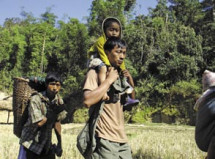Conflict or Peace? Ethnic Unrest Intensifies in Burma TNI-BCN Burma Policy Briefing Nr 7
Regiones
The breakdown in the ceasefire of the Kachin Independence Organisation (KIO) with the central government represents a major failure in national politics and threatens to escalate to serious humanitarian crisis if not immediately addressed.

Descargas
If you have trouble viewing this publication in PDF, please kindly use an alternative PDF viewer.
See also: International community must support non‐military solutions in northern Myanmar
Over 11,000 refugees have been displaced and dozens of casualties reported during two weeks of fighting between government forces and the KIO. Thousands of troops have been mobilized, bridges destroyed and communications disrupted, bringing hardship to communities across northeast Burma/Myanmar. There is now a real potential for ethnic conflict to further spread. In recent months, ceasefires have broken down with Karen and Shan opposition forces, and the ceasefire of the New Mon State Party (NMSP) in south Burma is under threat. Tensions between the government and United Wa State Army (UWSA) also continue.
It is essential that peace talks are initiated and grievances addressed so that ethnic conflict in Burma does not spiral into a new generation of militarised violence and human rights abuse. To date, no transparent or inclusive process of peace talks has been established. Burma remains a land in political transition, and the Kachin crisis signifies the first major challenge to the new government, under President ex-Gen. Thein Sein, that assumed power in March 2011. But no clear or coherent policy has emerged among government authorities to address the causes behind the KIO and other ethnic struggles. Different ministers, military officers and representatives in the new system of legislatures are competing to set policy. For its part, the KIO accuses generals of the national armed forces, known as the Tatmadaw, of continuing a long-term strategy to marginalize and repress ethnic minority groups.
Four months into the life of a new political system, ethnic tensions are deepening not reducing in the country.
Conclusions and Recommendations
- It is imperative that ceasefire talks resume and that all armed actors, both government and KIO, pursue peaceful processes that will bring lasting inclusion and stability. Priority must be given to the humanitarian needs of peoples in the conflict-zones.
- The new government must seek to peacefully address ethnic conflicts in the country. The occasion of a new government provides an opportunity to resolve Burma’s long-standing political and ethnic crises. Failure in 2011 will only perpetuate conflict and state under-achievement for another generation.
- It is vital that the new government pursues policies that support dialogue and participation for all peoples in the new political and economic system. Many communities and parties remain marginalised outside the new structures of administration. Policies that continue to favour the armed forces and military solutions will perpetuate resentment and division.
- With the advent of a new government, opposition groups should seek to find ways to support progressive political reform through democratic processes. National unity and participation are essential to achieve democratic and ethnic reforms.
- The international community must promote conflict resolution, political rights and equitable opportunity for all ethnic groups in every sector of national life, including theeconomy, health and education. Burma is at a critical stage in political transformation. Policies that truly support national inclusion and stability are essential.
Pages: 8